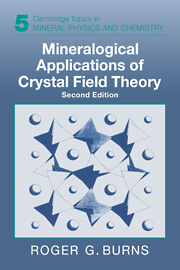Book contents
- Frontmatter
- Contents
- Preface to the first edition
- Preface to the second edition
- 1 Introduction
- 2 Outline of crystal field theory
- 3 Energy level diagrams and crystal field spectra of transition metal ions
- 4 Measurements of absorption spectra of minerals
- 5 Crystal field spectra of transition metal ions in minerals
- 6 Crystal chemistry of transition metal-bearing minerals
- 7 Thermodynamic properties influenced by crystal field energies
- 8 Trace element geochemistry: distribution of transition metals in the Earth's crust
- 9 Mantle geochemistry of the transition elements: optical spectra at elevated temperatures and pressures
- 10 Remote-sensing compositions of planetary surfaces: applications of reflectance spectra
- 11 Covalent bonding of the transition elements
- Appendices
- References
- Subject index
9 - Mantle geochemistry of the transition elements: optical spectra at elevated temperatures and pressures
Published online by Cambridge University Press: 23 November 2009
- Frontmatter
- Contents
- Preface to the first edition
- Preface to the second edition
- 1 Introduction
- 2 Outline of crystal field theory
- 3 Energy level diagrams and crystal field spectra of transition metal ions
- 4 Measurements of absorption spectra of minerals
- 5 Crystal field spectra of transition metal ions in minerals
- 6 Crystal chemistry of transition metal-bearing minerals
- 7 Thermodynamic properties influenced by crystal field energies
- 8 Trace element geochemistry: distribution of transition metals in the Earth's crust
- 9 Mantle geochemistry of the transition elements: optical spectra at elevated temperatures and pressures
- 10 Remote-sensing compositions of planetary surfaces: applications of reflectance spectra
- 11 Covalent bonding of the transition elements
- Appendices
- References
- Subject index
Summary
It is embarassing that the pressure experiments show the dependence of Δ upon the distance R between the metal and the ligand to be fairly close to that given by the point charge model.
S. Sugano & S. Oshnishi, in Material Science of the Earth's Interior. (I. Sunagawa, ed., Terra Scientific Publ. Co., Tokyo, 1984), p. 174Introduction
Considerable interest centres on the Mantle constituting, as it does, more than half of the Earth by volume and by weight. Attention has been focussed on several problems, including the chemical composition, mineralogy, phase transitions and element partitioning in the Mantle, and the geophysical properties of seismicity, heat transfer by radiation, electrical conductivity and magnetism in the Earth. Many of these properties of the Earth's interior are influenced by the electronic structures of transition metal ions in Mantle minerals at elevated temperatures and pressures. Such effects are amenable to interpretation by crystal field theory based on optical spectral data for minerals measured at elevated temperatures and pressures.
In the Mantle, temperatures range up to several thousands of degrees Kelvin and pressures may exceed 100 GPa in the deep interior, attaining 136 GPa at the Core–Mantle boundary. In the past two decades, the optical spectra of several minerals and synthetic analogues have been measured at high pressures and elevated temperatures simulating conditions in the interior of the Earth. The results of many of these high P and T spectral measurements are reviewed in this chapter and applications of the spectral data are described to transition metal-bearing Mantle minerals.
- Type
- Chapter
- Information
- Mineralogical Applications of Crystal Field Theory , pp. 353 - 395Publisher: Cambridge University PressPrint publication year: 1993



